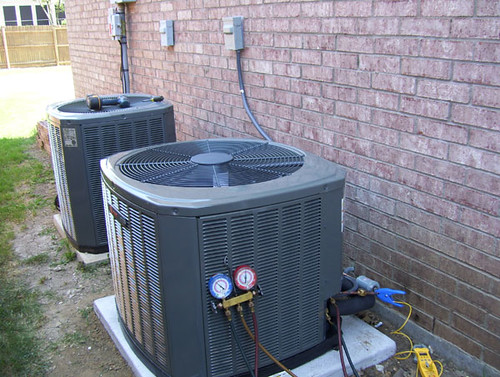(Originally an excerpt from NY24’s “Phoenix”. Published in V102, Number 5 of the National Engineer)
This may sound like a subject that’s too simple to discuss, yet there’s much to learn. Here are three common service problems:
- Most service technicians carry no tools to actually read pressure drops.
- Many common coil-cleaning methods are poor and some damage both coils and people.
- Hardly anyone, including manufacturers, know what to do about stinking evaporator coils.
WHEN A COIL IS CLOGGED. This sounds like an easy problem. All you have to do is look… right? I’ve been on many jobs where a recently cleaned coil looked spotless on the surface. Yet, upon further examination, the inner rows were completely clogged with grease or small particulate matter.
On one such job, the symptom was an unusually high number of condenser coil. The problem as complicated by the fact that the most recent motor to fail was totally-open instead of the recommended top-enclosed type. This led me to believe the failure was caused by rain entering the motor windings (which did happen, but it wasn’t the cause of the repeat failures).
After replacing the motors with the correct type, it also failed within 48 hours.
Although nothing was noticeable on the coil surface, the pressure on the inside of the condenser (in relation to the atmospheric pressure) revealed a static pressure of .5in. wg. magnehelic.
For most residential and light commercial machines using propeller-type fans, this is considerable higher than what the pressure across the coil surface should be. Maximum static pressure probably shouldn’t exceed .2-in. Due to the horsepower leading to early failure.
With centrifugal evaporator fans, however, a clogged coil won’t cause motor failure. The reason for this is, again, the centrifugal fan’s horsepower curve.
The symptoms of restricted airflow through an evaporator coil is low suction pressure and frost on the coil. This is one example where low air flow may not provide a large temperature drop between entering and leaving air. Why not? Such clogging disables whole sections of the coil, affecting thermal transfer.
Again, use a magnehelic or other air pressure measuring device to determine pressure-drop across the evaporator coil. The manufacturer’s design for a clean coil should be determined from their specifications. This varies according to design, fan speed, and whether the coil is wet or dry. Experience with residential and light commercial jobs show that most clean evaporators never exceed a static-pressure drop of .5-in. A good average would be >3-in. with a clean, dry coil.
COIL CLEANING. So what should you use to clean the coil? Perhaps I should start out by telling you what not to use. One of the most popular chemicals for cleaning condenser coils is something called a brightener. This cleaner typically foams when it hits the coil surface. It is popular because (supposedly):
- The foaming removes deep dirt.
- It removes the outer crust providing the coil better heat transfer.
- It brightens the coils surface, making it look like new.
That’s the bright side. However, the foaming is caused by a chemical reaction between the acid and the aluminum fins.
If you hold a burning match to the foam (please don’t try it), you’ll discover a highly-explosive hydrogen content of the bubbles. The coil surface is brightened because the protective outer oxide coating is removed—but just temporarily.
I discourage this use of corrosive foaming coil cleaners because:
- They are extremely hazardous—accidental misuse can cause burns and blindness.
- They destroy the aluminum fins—each acid cleaning removes an average ½ oz of fin material from a typical coil.
They rapidly degrade the bond between the aluminum fins and the copper tubes by accelerating electrolysis, permanently lower coil efficiency and life.
What about foaming cleaners with labels saying “non-acid?” In most cases, the active ingredient here is a very strong, very active alkali. The hazards and results are the same as acid cleaners.
So, what should you use? Well, most safe cleaners won’t provide results as the corrosives. They won’t foam upon hitting the coil surface, nor will they brighten the aluminum—but they will do a good job if allowed to soak in. There are many fine detergents on the market, as well as some good cleaning methods. The trick is to use the right method and cleaner for each situation.
If the problem is just a surface loaded with debris, a vacuum cleaner with a small brush and crevice tool is your best bet.
Where grease is the problem, soaking the coil with a degreaser and letting it sit for a while before rinsing is a sensible solution. High pressure cleaning with a good cleanser, blowing outward from the inside, is the most effective way to clean deeply loaded coils.
Many service mechanics are reluctant to clean spine-type coils with high-pressure hoses because they’re afraid of bending the spines. Actually, other than for aesthetic reasons, this should be of little concern. Tests by one of the manufacturers showed that in a worse case situation affecting all front and rear surfaces, bending spine fins will degrade total efficiency less than 10%. Of course, this isn’t true of plate fin coils.
Article originally published from the July 1998 issue of the National Engineer.
Photo Credit: “A/C Tune up check” by jackiebese is licensed under CC BY-SA 2.0
Interested in learning More?
Check out our Refrigeration and AC Plant Operation Online Course.
